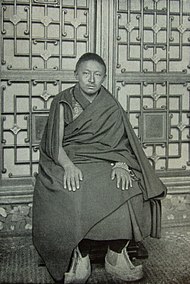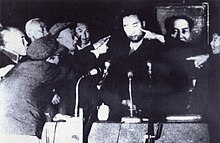
The Gelug is the newest of the four major schools of Tibetan Buddhism. It was founded by Je Tsongkhapa (1357–1419), a Tibetan philosopher, tantric yogi and lama and further expanded and developed by his disciples.
A tulku is a distinctive and significant aspect of Tibetan Buddhism, embodying the concept of enlightened beings taking corporeal forms to continue the lineage of specific teachings. The term "tulku" has its origins in the Tibetan word "sprul sku", which originally referred to an emperor or ruler taking human form on Earth, signifying a divine incarnation. Over time, this term evolved within Tibetan Buddhism to denote the corporeal existence of highly accomplished Buddhist masters whose purpose is to ensure the preservation and transmission of a particular lineage.

Chökyi Gyalpo, also referred to by his secular name Gyaincain Norbu or Gyaltsen Norbu, is considered the 11th Panchen Lama by the government of the People's Republic of China (PRC). He is also the vice president of the Buddhist Association of China. Gyalpo is considered to be a proxy of the Chinese government.
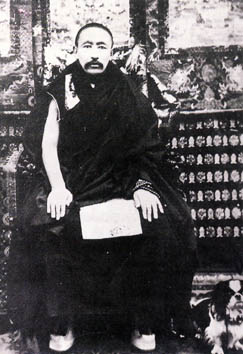
Thubten Choekyi Nyima (1883–1937), often referred to as Choekyi Nyima, was the ninth Panchen Lama of Tibet.

Lobsang Trinley Lhündrub Chökyi Gyaltsen was the tenth Panchen Lama, officially the 10th Panchen Erdeni, of the Gelug school of Tibetan Buddhism. According to Tibetan Buddhism, Panchen Lamas are living emanations of the buddha Amitabha. He was often referred to simply as Choekyi Gyaltsen.

Gedun Gyatso, also Gendun Gyatso Palzangpo, was considered posthumously to have been the second Dalai Lama.

Ngawang Lobsang Gyatso was the 5th Dalai Lama and the first Dalai Lama to wield effective temporal and spiritual power over all Tibet. He is often referred to simply as the Great Fifth, being a key religious and temporal leader of Tibetan Buddhism and Tibet. Gyatso is credited with unifying all Tibet under the Ganden Phodrang after a Mongol military intervention which ended a protracted era of civil wars. As an independent head of state, he established relations with the Qing empire and other regional countries and also met early European explorers. Gyatso also wrote 24 volumes' worth of scholarly and religious works on a wide range of subjects.
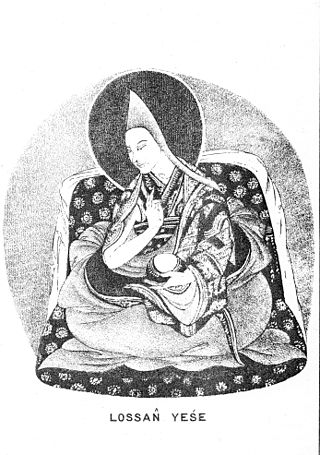
Lobsang Yeshe (1663–1737) was the fifth Panchen Lama of Tibet.

Tashi Lhunpo Monastery is an historically and culturally important monastery in Shigatse, the second-largest city in Tibet. Founded in 1447 by the 1st Dalai Lama, it is the traditional monastic seat of the Panchen Lama.

The 11th Panchen Lama controversy centers on the 28 year-long enforced disappearance of Gedhun Choekyi Nyima and on the recognition of the 11th Kunsik Panchen Lama. The Panchen Lama is considered the second most important spiritual leader in Tibetan Buddhism after the Dalai Lama. Following the death of the 10th Panchen Lama, the 14th Dalai Lama recognized Gedhun Choekyi Nyima in 1995. Three days later, the People's Republic of China (PRC) abducted the Panchen Lama and his family. Months later, the PRC chose Gyaincain Norbu as its proxy Panchen Lama. During the traditional search process led by Chadrel Rinpoche, he indicated to the Dalai Lama that all signs pointed to Gedhun Choekyi Nyima, while the Dalai Lamas and Panchen Lamas recognize each other's incarnations. The PRC had established its own search committee, which included Chatral Rinpoche and other monks, and wanted to use a lottery system referred to as the Golden Urn. Neither Gedhun Choekyi Nyima nor his family have been seen since the abduction. Chatral Rinpoche was also arrested by Chinese authorities the day of the abduction.
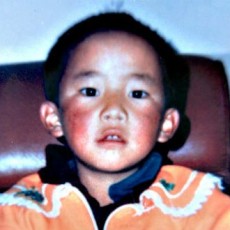
Gedhun Choekyi Nyima is the 11th Panchen Lama belonging to the Gelugpa school of Tibetan Buddhism, as recognized and announced by the 14th Dalai Lama on 14 May 1995. Three days later on 17 May, the 6-year-old Panchen Lama was kidnapped and forcibly disappeared by the Chinese government, after the State Council of the People's Republic of China failed in its efforts to install a substitute. A Chinese substitute is seen as a political tool to undermine the reincarnation of the Dalai Lama, which traditionally is recognized by the Panchen Lama. Gedhun Choekyi Nyima remains forcibly detained by the Chinese government, along with his family, in an undisclosed location since 1995. His khenpo, Chadrel Rinpoche, and another Gelugpa monk, Jampa Chungla, were also arrested. The United Nations, with the support of numerous states, organizations, and private individuals continue to call for the 11th Panchen Lama's release.

Losang Chö kyi Gyaltsen (1570–1662) was the fourth Panchen Lama of the Gelug school of Tibetan Buddhism and the first to be accorded this title during his lifetime.
Palden Tenpai Nyima (1782–1853) was the 7th Panchen Lama of Tibet.

Reting Rinpoche was a title held by abbots of Reting Monastery, a Buddhist monastery in central Tibet.

Lobsang Tubten Jigme Gyatso (bot=བློ་བཟང་ཐུབ་བསྟན་འཇིགས་མེད་རྒྱ་མཚོ་), officially the 8th Arjia Hotogtu(bot=ཨ་ཀྱཱ་ཧོ་ཐོག་ཐུ།), born 1950 in Haiyan County, Qinghai) is one of the most prominent Buddhist teachers and lamas to have left Tibet. At age two, Arjia Rinpoche was recognized by Choekyi Gyaltsen, 10th Panchen Lama as the 20th Arjia Danpei Gyaltsen, the reincarnation of Je Tsongkhapa's father, Lumbum Ghe, the throne holder and abbot of Kumbum Monastery. He has trained with lineage teachers, such as the 14th Dalai Lama, the 10th Panchen Lama, and Gyayak Rinpoche—from whom he received many sacred teachings and ritual instructions.
The Golden Urn refers to a method for selecting Tibetan reincarnations by drawing lots or tally sticks from a Golden Urn introduced by the Qing dynasty of China in 1793. After the Sino-Nepalese War, the Qianlong Emperor promulgated the 29-Article Ordinance for the More Effective Governing of Tibet, which included regulations on the selection of lamas. The Golden Urn was introduced ostensibly to prevent cheating and corruption in the selection process but also to position the Qianlong Emperor as a religious authority capable of adducing incarnation candidates. A number of lamas, such as the 8th and 9th Panchen Lamas and the 10th Dalai Lama, were confirmed using the Golden Urn. In cases where the Golden Urn was not used, the amban was consulted. Golden Urn was exempted for Lhamo Dhondup to become the 14th Dalai Lama in 1940.

Trülku Drakpa Gyeltsen (1619–1656) was an important Gelugpa lama and a contemporary of the 5th Dalai Lama (1617–1682). His Seat was the upper residence of Drepung Monastery, a famous Gelug gompa located near Lhasa.

The Samding Dorje Phagmo is the highest female incarnation in Tibet and the third highest-ranking person in the hierarchy after the Dalai Lama and the Panchen Lama. She was listed among the highest-ranking reincarnations at the time of the 5th Dalai Lama, recognized by the Tibetan government and acknowledged by the emperors of Qing China. In her first incarnation, as Chökyi Drönma, she was the student and consort of the famous polymath Thang Tong Gyalpo, who first identified her as an emanation of Vajravārāhī, and the consort of Bodong Panchen. The seat of the Samding Dorje Phagmo is at Samding Monastery, in Tibet.

Yeshe Lobsang Tenpai Gonpo was the 8th Tatsag, a Tibetan reincarnation lineage. From 1789 to 1790 and from 1791 until his death in 1810 he was regent of Tibet, appointed by the Qing dynasty of China. He was the first owner of the Kundeling Monastery, founded in 1794 in Lhasa.

Chadrel Rinpoche was born in 1939 in Shigatse, Tibet. He was also known formally as Jadrel Jampa Thinley Rinpoche, and was a Gelug school Rinpoche of Tibetan Buddhism. In 1954, he joined the Tashilhunpo Monastery at the age of 15, and was forced to work in a labor camp during the Cultural Revolution in Tibet. He was a close student of Choekyi Gyaltsen, the 10th Panchen Lama. Later Chadrel Rinpoche became the head Khenpo of the Tashilhunpo Monastery. In 1989, Chadrel Rinpoche was appointed to lead the Chinese efforts to locate the reincarnated 11th Panchen Lama. In February 1995 while in Beijing, he refused plans to substitute the reincarnate Gedhun Choekyi Nyima with another boy. As a result, he was arrested after Gedhun Choekyi Nyima was formally recognized, then he was continually imprisoned and held under house arrest until his reported suspicious death from poisoning in 2011. He was also a Member of the 7th and 8th Chinese People's Political Consultative Conference (CPPCC).



